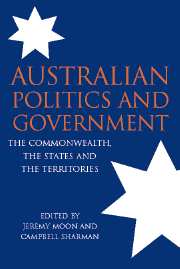Book contents
- Frontmatter
- Contents
- List of contributors
- List of figures and tables
- Acknowledgements
- 1 Introduction
- 2 The Commonwealth
- 3 New South Wales
- 4 Queensland
- 5 South Australia
- 6 Tasmania
- 7 Victoria
- 8 Western Australia
- 9 Australian Capital Territory
- 10 Northern Territory
- 11 One System or Nine?
- Note on Sources and Links to the Web
- Notes
- Appendix: Periods in Office
- References
- Index
1 - Introduction
Published online by Cambridge University Press: 05 September 2012
- Frontmatter
- Contents
- List of contributors
- List of figures and tables
- Acknowledgements
- 1 Introduction
- 2 The Commonwealth
- 3 New South Wales
- 4 Queensland
- 5 South Australia
- 6 Tasmania
- 7 Victoria
- 8 Western Australia
- 9 Australian Capital Territory
- 10 Northern Territory
- 11 One System or Nine?
- Note on Sources and Links to the Web
- Notes
- Appendix: Periods in Office
- References
- Index
Summary
The centenary of federation marks the growth of the Commonwealth government from a single public servant on 1 January 1901 to its current role as a national government with involvement, direct or indirect, in almost every area of public policy. This growth has taken place in the context of a federal system whose other components, the states, have also seen a massive expansion of their role over the last hundred years. If there was a major theme to the history of democratic politics in the twentieth century it was the extension of government in response to the ever-expanding expectations of citizens and voters.
In the Australian context, this enlargement of the role of government has been inextricably linked to the evolution of the federal system. The states, now joined by the Northern Territory and the Australian Capital Territory, continue to deliver the great bulk of the day-to-day services expected of government – health, education, transport, the maintenance of public order, land use and the host of regulations affecting social and economic transactions of all kinds. But, in addition to its stated constitutional responsibilities for international relations and commercially related issues extending across the federation, the central government is now involved to some degree in most areas of public policy making. This has been achieved in large part through the leverage that the Commonwealth's superior access to taxation revenue has given it in making conditional grants to the states; in several important areas, the constitutional interpretations of the High Court have also been of major importance in extending the influence of the national government.
- Type
- Chapter
- Information
- Australian Politics and GovernmentThe Commonwealth, the States and the Territories, pp. 1 - 11Publisher: Cambridge University PressPrint publication year: 2003
- 2
- Cited by



